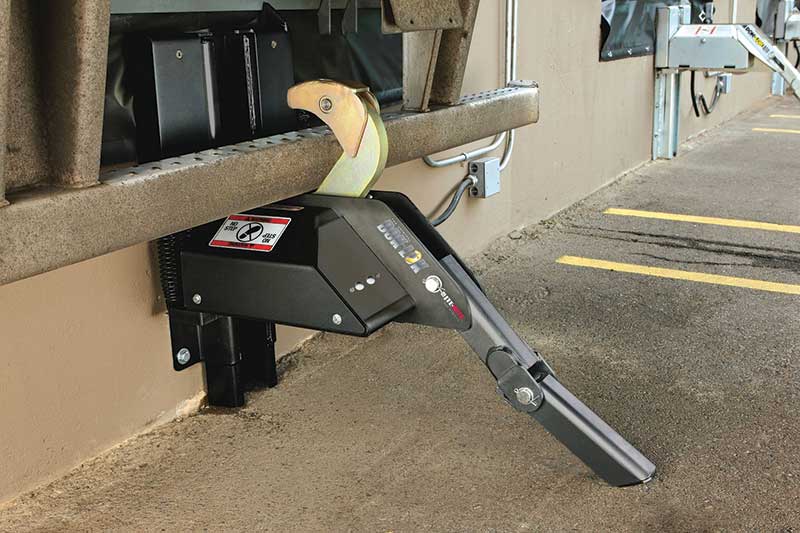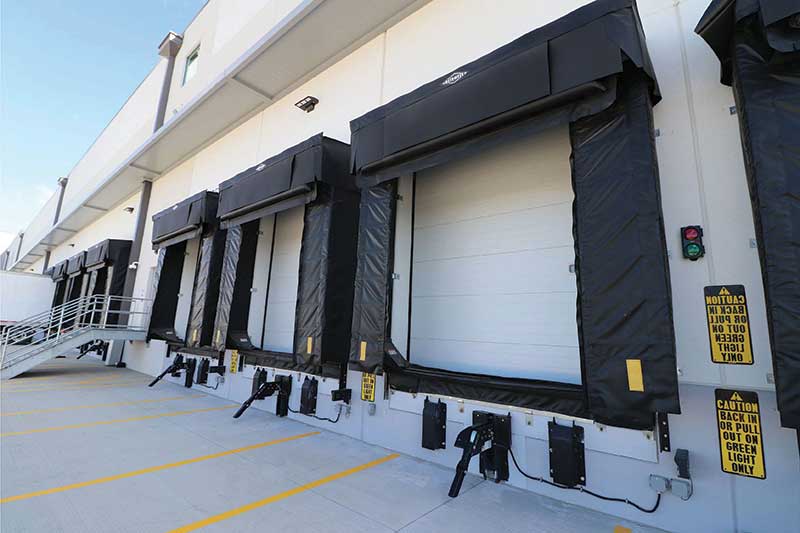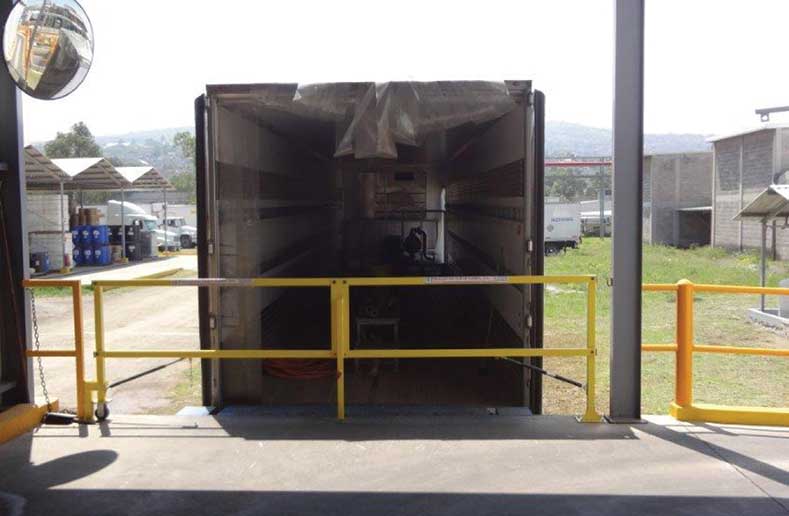Destination: Loading dock safety
Vehicle restraints help prevent the most common dock accident—early truck pull away.

Never underestimate the power of dock safety.
Sounds simple enough as a premise. However, don’t underestimate the number of ways things can go sideways at any dock whether you have two or 200 of them. And, the potential for injury is acute.
Consider this simple (or not so simple) sequence that must happen multiple times a day 100% correctly. A 53-foot trailer needs to back into the dock position. The trailer needs to line up with the dock door so the vehicle restraint securely grabs the rear impact guard (RIG) bar on the back of the trailer.
Meanwhile, a leveler needs to bridge the gap from the dock itself and the back of the trailer. From there, people and lift trucks need to unload the truck before it leaves for another destination.
That’s a lot of “needs” to unload one trailer, let alone many. All with plenty of noise and good old-fashioned pressure (maybe even yelling) to hurry-up-the-unload-and-reload faster than before.
Or to put it another way: “Docks are one of the most vulnerable areas in any facility,” says Joe Ellestad, director of customer relations and sales support at Rite-Hite.
Fortunately, a range of equipment from levelers and vehicle restraints to seals/shelters and guards can improve dock operations while protecting associates from injury on the job.
But that equipment can’t go it alone for safety’s sake. Set-in-stone procedures and precautions are also critical. This is where control panels and related systems and software ensure equipment is activated in the right sequence to ensure worker safety.
“With new online software systems, there’s a great peace of mind from managing dock activities so that they occur as they should,” says Ryan Schaffner, director of sales at McGuire, a division of Systems LLC. That’s the power of dock safety.

Getting started
The power of safety starts long before any dock equipment is selected, let alone installed and used daily.
“We don’t go five minutes into our orientation presentation for new clients without talking about safety,” says Ellestad.
“Operations managers have to be safety savvy from the first day they start planning how their docks will operate,” explains Rich Schlesinger, director of U.S. distribution sales at 4Front Engineered Solutions.
As Schaffner adds, “every equipment selection decision directly affects how a facility’s docks will operate for the next 10 years and even longer.”
Actually, the future plays a large role in dock safety. And Schlesinger says companies are on to it.
“It used to be that dock safety was important at individual facilities. But that’s evolved into being critical across all facilities of many companies. There is more interest than ever at the corporate level of being proactive about dock safety,” says Schlesinger.
Quite simply, companies see a direct link between safety and future success. It’s not just about the trailer unloading at 3 p.m. Instead, what happens without incident at 3 p.m. allows the next successful unloading at 4 p.m. and on to tomorrow. Without safety, there is no tomorrow.
Vehicle restraints
Schlesinger explains the most common accident is accidental truck pull away. That brings us to vehicle restraints.
At the back of each trailer and positioned under the floor bed is an ICC (Interstate Commerce Commission) bar, also known as a RIG. This is what the vehicle restraint grabs and secures so the trailer doesn’t creep away (or worse yet is unexpectedly driven away) from the dock.
“Every inch counts here,” says Ellestad. In fact, an inch movement of the truck in either position can mean a 6-inch or greater movement away from the building simply with the trucks’ air suspension system running.
It’s important to note that not every facility has vehicle restraints. This is where OSHA comes into the picture. The agency requires that, at a minimum, wheel chocks be put in place to stabilize the trailer. And even if a restraint is in use, wheel chocks are still recommended.
As you would expect, dock equipment suppliers each have their own design.
Ellestad talks about Rite-Hite’s SHR-5000 shadow hook restraint. It has a wide working range, up to 30 inches, and a track that resists up to 100,000 pounds of pull out force when attached to the dock wall. The restraint itself resists up to 32,000 pounds of force.
McGurire’s TPR Unilock vehicle restraint also resists 32,000 pounds of force at 30 inches, explains Schaffner. It has an internal safety mechanism that locks the restraint’s hook in place as pressure is applied from the RIG bar, and an offset cam design to avoid getting wedged on the RIG.
To keep trailers with redesigned pentagonal ICC bars more stable, says Schlesinger, 4Front’s new Talon vehicle restraint provides true five-sided ICC bar capture while eliminating hook pinch.
But getting that trailer restrained is only the first step to unloading.
As Schaffner explains, 90% of all restraints are powered. This allows activation with a simple push button. “In interlocked dock systems, that vehicle restraint activation allows the dock door to be opened and the dock leveler to be lowered into position,” adds Schaffner.
Sequence very much matters here. Violate it and associates are open to unsafe conditions including dock equipment that is improperly positioned to do its job.
Dock levelers
Dock levelers are big. And cumbersome.
So, it seems almost unlikely that anyone would want a mechanical leveler. These require someone to grab a pull chain to release the guarding that keeps the leveler vertical between uses. Then that person literally walks the leveler down to a horizontal position. By any measure, this introduces several ergonomic challenges.
That said, mechanical levelers have historically accounted for roughly 50% of all leveler sales, says Schaffner. Yes, about half of all levelers are manual.
Now, the ergonomics of an air- or hydraulic-powered leveler are clearly superior to mechanical ones. The operator simply pushes a button and the leveler, using air or hydraulics, guides the unit into position from the dock edge into the trailer bed.
But that convenience comes at a cost premium. About 25% on average, explains Schaffner. But that hasn’t dissuaded companies such as Amazon, Lowe’s, Walmart and Home Depot, among many others, to opt for the improved ergonomics of powered levelers.
Rather than focusing on the upfront cost, says Schaffner, these and many other companies have focused on the total cost of ownership (TCO). Over the 10-year lifetime of a powered leveler, TCO is about 15% to 20% lower, says Schaffner. That is attributable to improved worker safety, lower maintenance costs and enhanced operational efficiency.
Ease of use is also a large factor in the decision for a powered leveler. “Once you’ve used a push button, you don’t go back to walking down a leveler,” Schaffner says.
Seals/shelters and guarding
While vehicle restraints and levelers are active safety participants at the dock, seals/shelters and guarding provide safety passively to all involved.
“It’s great that a trailer is backing into the dock so well, but it’s also a 53-foot-long rain and snow collector,” says Schlesinger.
Without seals/shelters to protect the dock from all that moisture, safety can still be a concern, especially if someone is walking down that leveler.
Ellestad explains that the head pad of the seal snugs up against the trailer, keeping out weather from above. Meanwhile, shelter curtains do the same from the top of the trailer to its bed. Typically, both can be adjusted to the specific trailer at the dock.
Safety takes on still another dimension when it comes to guarding, says Ray Niemeyer, vice president of sales at SpaceGuard Products. As he explains, guarding protects both equipment and people inside the building at the loading dock, and they both need the added protection.
Now, guarding is probably the lowest tech safety equipment at the dock and is often overlooked. It can range from simple hand rails to pedestrian guard rails that keep people away from lift truck travel lanes. Designated driving lanes outlined by striped floors as well as bumpers and buffer guards help to protect moving equipment from hitting people.
Other guarding variations include fall protection barriers stretched across an open dock door. OSHA mandates guarding for fall protection wherever you have drops of 48 inches or more.
The idea is to prevent busy associates from losing track of where they are relative to the open dock door and falling off the dock when no trailer is in place. Gates are part of this protection mix, too.
Adequate dock lighting is considered a safety precaution. These range from simple incandescent light bulbs to the broad availability and use of LED lights these days. Quite simply, lift truck drivers need them to see people as they move in and out of the trailer.
Control systems
Lights (red and green to be precise) bring another safety dimension to docks, especially when part of advanced control systems.
Now, control systems are not new. But they are the future of dock safety, explains Schlesinger.
Quite simply, control panels and related software systems exponentially improve dock safety by managing the operation of even 200 docks simultaneously as well as the sequence of operations at each dock. It’s a long way from white boards and golf carts to track and check dock operations.
These control systems collect data and perform analytics on all dock operations. They provide a dashboard of current activities along with a dashboard of historical data all the way down to how many times Dock 6 was used in the past 30 days, for instance. Needless to say, usage data has a direct impact on maintenance decisions for extending safe use of dock equipment.
As to those red and green lights, they communicate dock readiness to both those inside the facility and the truck driver outside. It’s not only a time saver but a simple, universally understood tool of a dock’s status.
When all is said and done, dock safety is not at all aspirational. It is very attainable day in and day out. But it’s also a choice of every operational manager with dock responsibilities.


Article Topics
McGuire News & Resources
Destination: Loading dock safety Chamberlain Group acquires Systems, Inc. Henrich Logistics replaces its mechanical levelers with air-powered levelersLatest in Materials Handling
Geek+ and System Teknik deploy PopPick solution for pharmacy group Med24.dk Beckhoff USA opens new office in Austin, Texas Manhattan Associates selects TeamViewer as partner for warehouse vision picking ASME Foundation wins grant for technical workforce development The (Not So) Secret Weapons: How Key Cabinets and Asset Management Lockers Are Changing Supply Chain Operations MODEX C-Suite Interview with Harold Vanasse: The perfect blend of automation and sustainability Consultant and industry leader John M. Hill passes on at age 86 More Materials HandlingAbout the Author
Subscribe to Materials Handling Magazine

Find out what the world's most innovative companies are doing to improve productivity in their plants and distribution centers.
Start your FREE subscription today.
April 2024 Modern Materials Handling

Latest Resources











